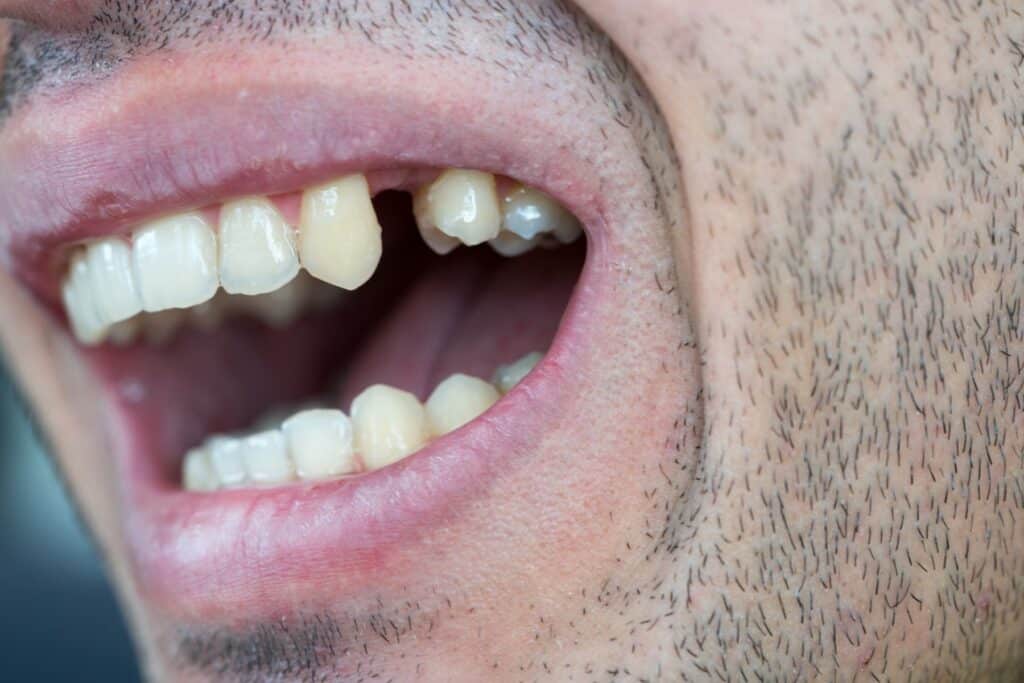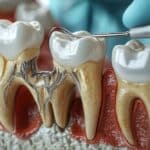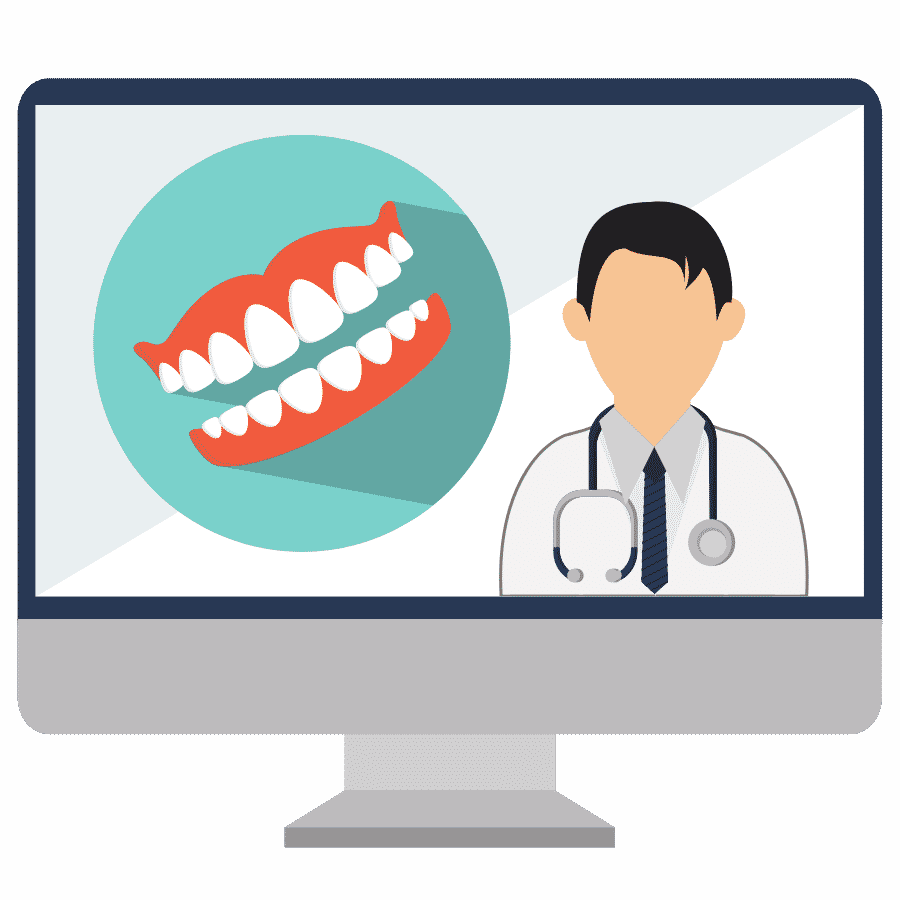Sampling the cookies your best friend made with her favorite recipe. Displaying a big grin when the photographer yells, “Say cheese!” Trying out for a speaking role in the latest community theatre production without worrying that you’ll trip up on your lines due to failing or missing teeth.
These are all common activities that most people take for granted – until bad teeth get in the way.
If you’re dealing with problem teeth, you’re undoubtedly looking for solutions that will help you get back on track toward living your best life without worrying about mouth pain, the appearance of your smile or whether you can enjoy a healthy meal at the family dinner table or your favorite restaurant.
The answers you’re after depend largely on the extent of your tooth decay or damage. If you’re in the early stages of tooth decay or you have only one broken or chipped tooth, your options will be quite different from those of a person who has many failing or missing teeth or has experienced many years of declining oral health.
Why it’s important to address failing teeth
Having confidence in your smile is reason enough to take care of your teeth. But did you know that the condition of your teeth and gums can have a big impact on your overall health? When you think about it, this is not surprising. After all, your mouth is the gateway to your digestive and respiratory tracts. Studies have linked problems with declining teeth and gums to serious health conditions, including cardiovascular disease.
Additionally, when you have toothaches or you try to steer clear of a gap in your teeth while chewing food, you may consciously or unconsciously start avoiding nutritious foods that your body needs to stay healthy. For example, consistently choosing easy-to-chew processed foods instead of fresh fruit and vegetables can deprive your body of essential nutrients like vitamins C and E.
Whether your damaged teeth are the result of lax oral hygiene habits or some other cause, you’ll want to take corrective action right away to prevent further deterioration of your overall health.
Causes of failing teeth
You’re hardly alone if you’re dealing with missing or failing teeth. According to the American College of Prosthodontists, an estimated 178 million Americans have at least one missing tooth, and about 40 million have lost all their teeth. Many more people have broken, loose or decaying teeth that interfere with their routine daily activities and undermine their self-esteem.
The detrimental effects of bad teeth tend to be similar no matter the cause, but the reasons for tooth damage can vary widely. Here are a few of the most common:
Periodontal disease
Also known as advanced gum disease, periodontal disease is the top cause of tooth loss in adults, according to the National Institute of Dental and Craniofacial Research. Inflammation caused by bacterial infections can cause gums to pull away from the teeth, exposing the roots to damage and even leading to teeth becoming loose and falling out.

Tobacco use
Experts say smokers are three times more likely than non-smokers to develop periodontal disease, which in turn makes them more susceptible to tooth loss. Smokeless tobacco, also known as dip, chewing tobacco or snuff, typically contains sugar along with other chemicals that can promote cavities and gum disease, according to the American Dental Association (ADA). What’s more, both types of tobacco use cause unsightly dental stains.
Failure to get routine professional dental care
Most people don’t look forward to visiting a dentist for routine exams and professional teeth cleanings, and today’s busy lifestyles can make it difficult to find time for annual or semiannual appointments. However, the importance of seeing dental professionals on a regular basis can’t be overstated. After all, the Centers for Disease Control and Prevention (CDC) lists periodontal disease and tooth decay as the biggest threats to dental health.
Your dentist has the training and technology to identify signs of gum disease and tooth decay that would otherwise be missed. Likewise, dental hygienists have the training and tools to dislodge decay-causing plaque and tartar in ways that can’t be duplicated by even the most diligent at-home oral hygiene regimen.
General health conditions
Scientists have identified many chronic health conditions that can increase a person’s risk of tooth loss. These conditions include diabetes, high blood pressure and several autoimmune diseases, as well as certain cardiovascular and neurological conditions. Additionally, according to the CDC, hormonal changes during pregnancy may aggravate gum inflammation for women who have mild to moderate gum disease. Menopause is another stage of hormonal change that can cause tooth and bone loss in women.
What’s more, certain medical treatments – such as chemotherapy and radiation for cancer – can increase the patient’s potential for tooth loss.
Genetic predisposition to tooth loss

Some inherited health conditions create an elevated risk for periodontitis and tooth decay. One example is Sjogren’s syndrome, an autoimmune disease that attacks moisture-creating glands and causes chronic dry mouth. The shortage of saliva, which helps protect gums from infection and teeth from enamel erosion, can put a person with Sjogren’s at high risk for tooth loss.
Tooth agenesis is another hereditary condition that causes a lack of teeth. It’s a rare condition that can prevent teeth from ever developing – which is known as anodontia – or cause a person to have several missing teeth.
Moreover, research has revealed that certain inherited genes can increase the likelihood that a person will develop periodontitis or cavities, both of which can lead to tooth loss. However, experts say tooth and gum deterioration usually results from a combination of several factors, which may include genetic predisposition, poor dental hygiene and environmental factors.
Traumatic dental injury
A blow to the mouth during a fall, car accident or sports injury can chip, loosen or dislodge teeth. Teeth can also be damaged by biting down on a hard object, such as a bone or an ice cube. Additionally, the ligaments that hold teeth in place can become damaged, leading to a condition known as bruised teeth syndrome. If untreated, these injuries can increase the risk of infection and eventually tooth loss.
Teeth grinding
People who continually grind or clench their teeth, a habit known as bruxism, have a higher risk of gum recession and tooth damage, both of which can lead to tooth loss. Clenching teeth can even damage the underlying bone that supports the teeth. Bruxism is often caused by misaligned teeth and exacerbated by anxiety or certain medications. The habit typically occurs during sleep, making it difficult to control, although mouth guards can help minimize the damage.
Aging

An estimated 20% of Americans 65 and older have no natural teeth, according to the CDC. But tooth loss is not an inevitable side effect of aging. In many cases, older Americans stop visiting their dentist after retirement because they no longer have employer-provided dental insurance. They are also more likely to have underlying health conditions and take medications that cause dry mouth, which can make their teeth more susceptible to tooth decay. What’s more, many seniors have ill-fitting dentures that can exacerbate existing dental problems and lead to increasing tooth loss.
Signs and symptoms of failing teeth
In many cases, the signs that a tooth is starting to fail are hard to miss. For example, loose permanent teeth and throbbing toothaches are symptoms that should have you scheduling a dental appointment right away.
Other signs of dental problems can be subtle. Untreated cavities can lead to tooth and gum infections that cause headaches. A tooth’s sensitivity to hot and/or cold food and beverages can signal the development of a cavity. And red, puffy gums provide a warning sign of gum disease that can threaten the health of your teeth.
Tooth decay typically begins with the development of cavities, or tiny holes that start in the tooth’s surface. These are caused by bacteria (dental plaque) and acid that build up on the teeth and wear down the enamel. Regular brushing and flossing are the best ways to prevent cavities and, in some cases, saliva can repair damage in the early stages. However, dental cavities are among the most common health conditions for both children and adults. More than 80% of Americans have had at least one cavity by the time they reach their mid-30s.
Periodontal disease and the resulting gum recession are additional leading causes of tooth decay. When the gums recede, they expose the teeth’s roots to plaque and acid that can rot the teeth and, if not identified and treated early, lead to tooth loss.
Ideally, routine dental visits and X-rays identify cavities and tooth decay due to gum disease.
Symptoms that indicate the need for a dental visit include:
- Toothache and sensitivity
- Brown, black or white staining on teeth
- Chips or cracks in one or more teeth
- Red, swollen or bleeding gums
- Gums pulling away from teeth
- Loose teeth
- Persistent bad breath

Maintenance required for rotting or damaged teeth
Most dental problems are the result of inadequate oral hygiene. Caring for teeth and gums that are beginning to show signs of deterioration is similar to preventative maintenance, but it’s even more important to make sure you brush and floss your teeth daily as recommended by dental experts.
You may also wish to use professional or over-the-counter mouth rinse products that are specially designed to kill bacteria or add fluoride protection for your teeth. Ask your dentist to recommend the best toothbrush to use for your specific oral health condition. The ADA recommends soft-bristle brushes; but beyond that, you’ll have a wide variety of options, including manual and electric toothbrushes and even brushes designed to target gum disease. Individuals with arthritis or other health conditions that make gripping difficult should look for a toothbrush that’s easy to manipulate for the recommended two minutes of brushing twice a day. It’s also important to replace your toothbrush or bristle heads after three months of use to ensure your teeth are getting the full effects of daily cleaning.
Flossing, which aims to dislodge plaque and food debris from between your teeth, is another task to include in your daily oral hygiene routine. If you have sore or sensitive gums, loose teeth, crowns or dental implants, you might want to use a water flosser in place of or in conjunction with traditional string floss.
If your concern is a chipped or broken tooth, this can sometimes be repaired with a filling, crown (protective cap) or bonding. It is important to protect the tooth from further damage and infection and visit a dentist as soon as possible. An untreated chipped tooth can provide a gateway for bacteria that can lead to unnecessary tooth loss.
Maintaining a healthy diet also plays a critical role in keeping your jawbone, teeth and gums healthy and able to do their jobs. Experts recommend eating foods that are rich in calcium and phosphorous to promote healthy tooth enamel. These foods include dairy products, leafy greens, almonds, meat, poultry, fish and eggs. In addition to maintaining a healthy diet, it’s a good idea to take supplements like vitamins D and B12 to promote healthy jaws as well as teeth.
At-home practices to avoid
Although there are many steps you can take at home to care for your teeth and gums, some oral health solutions are better left to the professionals. For example, the use of hydrogen peroxide and baking soda has become popular for whitening teeth, and some people attempt to treat their periodontal disease with peroxide washes. These practices require caution.
Studies have shown that occasional use of well-diluted hydrogen peroxide (about 3%) can be beneficial, but using it too much or too often can actually damage your teeth and gums. What’s more, brushing your teeth with peroxide and baking soda on a regular basis can irreparably damage tooth enamel.
It’s also worth noting that some low-cost tooth replacement solutions available from dentists can do more harm than good in the long term. Among them are pop-on or snap-on veneers and temporary dentures known as “flippers.”
Dental veneers are intended to cover the front surface of one or more teeth that may be discolored or misshapen or have some other type of imperfection. Pop-on veneers are typically made of resin or acrylic and, unlike more durable and costly porcelain veneers, are designed to be removed. However, veneers of any kind are not recommended for patients with tooth decay or gum disease. Moreover, pop-on veneers are not bonded to teeth the way traditional veneers are, so they can allow bacteria and food debris to get between the veneer and the tooth and become trapped, which can worsen the condition of already-weakened teeth.
A flipper tooth is a partial denture intended to temporarily fill the gap left behind when a natural tooth is lost. While this may be an acceptable option for patients who are awaiting a higher-quality, custom tooth replacement, flipper teeth are often ill-fitting and can cause damage to gums and bone when used long term. Flippers are also typically made from materials that will deteriorate in a short time, increasing the likelihood of a poor fit and the potential for food and bacteria to be trapped between the tooth and the denture.
Dental services for bad teeth

People with bad teeth usually have many options for repair or replacement. The ideal fix depends on the extent of the damage as well as other factors that are unique to the individual. Solutions run the gamut from traditional fillings to repair cavities and prevent additional decay to dental implants that can permanently replace a rotten tooth with a custom-crafted lookalike that will last for decades. Sometimes a tooth that is severely cracked or has a deep cavity can be partially removed and covered with a protective crown. If the pulp inside the tooth has become infected as a result of the cavity, the patient may require a root canal, which is a procedure performed with general anesthesia to thoroughly disinfect the tooth and prevent further decay.
When to consider tooth extraction
The decision to try to save a failing or loose tooth or have it pulled can be difficult. Experts generally recommend saving a weakened tooth if it can be made healthy again. However, the best advice depends on the extent and cause of the problem. If a patient has multiple decayed teeth or severe periodontitis and is experiencing chronic pain – especially if previous dental repairs and deep cleanings have not remedied the problem – it may be time to consider tooth extraction and replacement. Additionally, some patients with widespread gum infection may face risks to their overall health, making full-mouth tooth extraction and replacement with dental implants the best step to take.
In other cases, people who have struggled with failing or missing teeth for years may choose to have surrounding natural teeth removed and replaced with long-lasting, full arch implants rather than go through the hassles and ongoing expense of dentures and bridges.
Whether you’re considering having one tooth pulled or getting all of your teeth replaced by full mouth dental implants, you’ll want to consult with a trusted dental professional. If you have multiple rotten or missing teeth, the experts at New Teeth Now will be happy to discuss the pros and cons of having them extracted and replaced with high-quality dental implants. At New Teeth Now, this procedure can be completed all in one day.
The importance of replacing missing teeth
Failure to replace one or more missing teeth can lead to bone loss; shifting of surrounding teeth, which can negatively affect a person’s bite; inability to chew certain foods; and possibly detrimental effects on speech and the appearance of one’s facial structure and smile.
Options for tooth restoration

The ideal solution for missing teeth will depend on the number of lost teeth and where they are in your mouth, as well as the amount of bone loss you may have incurred. The most common options are:
- Dental implants – These are medical devices that are surgically implanted in the jawbone to replace tooth roots and support artificial teeth. They are available as single implants or to replace all of the teeth in the upper or lower arch, or both.
- Crowns and bridges – A crown is a ceramic or porcelain cap that’s placed over a damaged tooth to protect it from infection and further decay. A bridge consists of a false tooth supported by crowns on either side.
- Dentures – These are removable appliances that can replace one or more missing teeth. Dentures are typically held in place by a special adhesive. They are removed at night and soaked in a special denture cleanser.
How New Teeth Now can help
Are you researching care for failing and missing teeth because you have quite a few in your upper or lower arch – or both – and you’re frustrated by the day-in, day-out dilemmas of your dental condition? If so, New Teeth Now may be able to help. Our extensively experienced, board-certified oral surgeons have helped hundreds of people transform their lives with full sets of beautiful replacement teeth that are easy to care for and do everything that natural teeth do.

When you reach out to New Teeth Now for information, our knowledgeable staff will help determine if you’re a candidate for full arch or full mouth dental implants. If you are, we can provide you with information about the benefits of choosing dental implants, including these:
A safe, comprehensive procedure
New Teeth Now takes pride in offering the full array of services needed to outfit patients with full mouth dental implants, all under one roof. Our services include dental exams and X-rays as well as a review of each patient’s medical history to design a customized plan for teeth replacement. On the day of the procedure, our services include teeth extraction and implant placement, which are performed while the patient is under general anesthesia to ensure a pain-free experience. Patients arrive in the morning and leave in the afternoon with a full set of functional teeth that are custom-crafted in our in-house lab. They later receive their final set of gorgeous, natural-looking teeth crafted from ultra-durable zirconia.
A worry-free long-term solution
Full mouth dental implants are designed to last a lifetime. All they require is maintenance that’s similar to the oral hygiene routine needed to keep natural teeth healthy. They’re a great one-and-done alternative to crowns, bridges and dentures that will need replacement after several years. Dental implants are also far more comfortable and reliable, so you can say goodbye to concerns about dentures that slip and affect your speech or appearance. Moreover, unlike tooth substitutes that don’t anchor in the jawbone, dental implants help keep the jawbone healthy by mimicking the chewing action of natural teeth. This helps prevent jawbone shrinkage that accelerates the appearance of facial aging.
A better value in the long run
Although some alternatives may cost less in the short term, patients typically enjoy a higher level of satisfaction with dental implants because no other teeth replacement options come as close to duplicating the look and function of natural teeth. Moreover, with proper care, dental implants can last a lifetime. Crowns and bridges often become dislodged over time and require replacement, while dentures must be refitted every few years because of jawbone shrinkage.
Take the first step toward a better life
New Teeth Now has several locations in Florida and California and welcomes patients from throughout the United States. Contact us today for more information about the benefits of full mouth dental implants and to schedule a consultation to find out whether you’re a candidate for this life-changing procedure.









